1998 GMC SIERRA flat tire
[x] Cancel search: flat tirePage 342 of 452
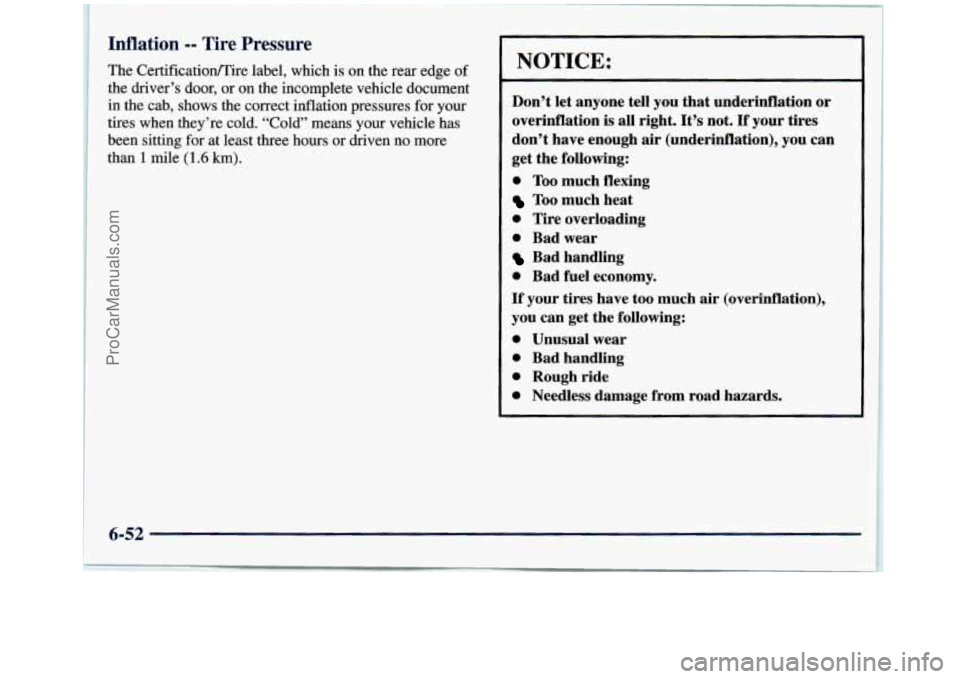
Inflation -- Tire Pressure
The CertificationlTire label, which is on the rear edge of
the driver’s door, or on the incomplete vehicle document
in the cab, shows the correct inflation pressures for your
tires when they’re cold.
“Cold” means your vehicle has
been sitting for at least three hours or driven no more
than
1 mile (1.6 krn).
NOTICE:
Don’t let anyone tell you that underinflation or
overinflation is all right.
It’s not. If your tires
don’t have enough
air (underinflation), you can
get the following:
0 Too much flexing
Too much heat
0 Tire overloading
0 Bad wear
Bad handling
0 Bad fuel economy.
If your tires have too much air (overinflation),
you can get the following:
0 Unusual wear
0 Bad handling
0 Rough ride
0 Needless damage from road hazards.
6-52
ProCarManuals.com
Page 343 of 452

When to Check
Check your tires once a month or more. Also, check the
tire pressure of the spare tire.
How to Check
Use a good quality pocket-type gage to check tire
pressure. You can’t tell if your tires are properly inflated
simply by looking at them. Radial tires may
look
properly inflated even when they’re underinflated.
Be sure
to put the valve caps back on the valve stems.
They help prevent leaks by keeping out dirt and moisture.
Tire Inspection and Rotation
Tires should be rotated every 6,000 to 8,000 miles
(10 000 to 13 000 km). Any time you notice unusual
wear, rotate your tires as soon as possible and check
wheel alignment.
Also check for damaged tires or
wheels.
See “When It‘s Time for New Tires” and
“Wheel Replacement” later in this section for more
information. If your vehicle has dual rear wheels, also
see “Dual Tire Operation” later
in this section. The purpose
of regular rotation
is to achieve more
uniform wear
for all tires on the vehicle. The first
rotation is the most important. See “Scheduled
Maintenance Services”
in the Index for scheduled
rotation intervals.
1
FRT FRT
[x[
If your vehicle has single rear wheels, always use one of
the correct rotation patterns shown here when rotating
your tires.
If your vehicle has front tires with different load ranges
or tread designs (such as all season vs. on/off road) than
the rear tires, don’t rotate your tires front
to rear.
6-53
ProCarManuals.com
Page 344 of 452

~ 11 your
vehicle has dual rear wheels and the load range
’ and tread design for your front tires is the same as your
rear tires, always use one of the correct rotation patterns
shown here when rotating your tires.
r.
If your vehicle has dual rear wheels and the load range
or tread design for your front tires is different from your
rear tires, always use the correct rotation pattern shown
here when rotating your tires. The dual tires are rotated
as a pair, and the inside rear tires become the outside
rear tires.
When you install dual wheels, be sure the vent holes in
the inner and outer wheels on each side are lined up.
After the tires have been rotated, adjust the front and
rear inflation pressures as shown
on the
Certificatioflire label. Make certain that all wheel nuts
are properly tightened. See “Wheel Nut Torque’’ in
the Index.
6-54
ProCarManuals.com
Page 345 of 452
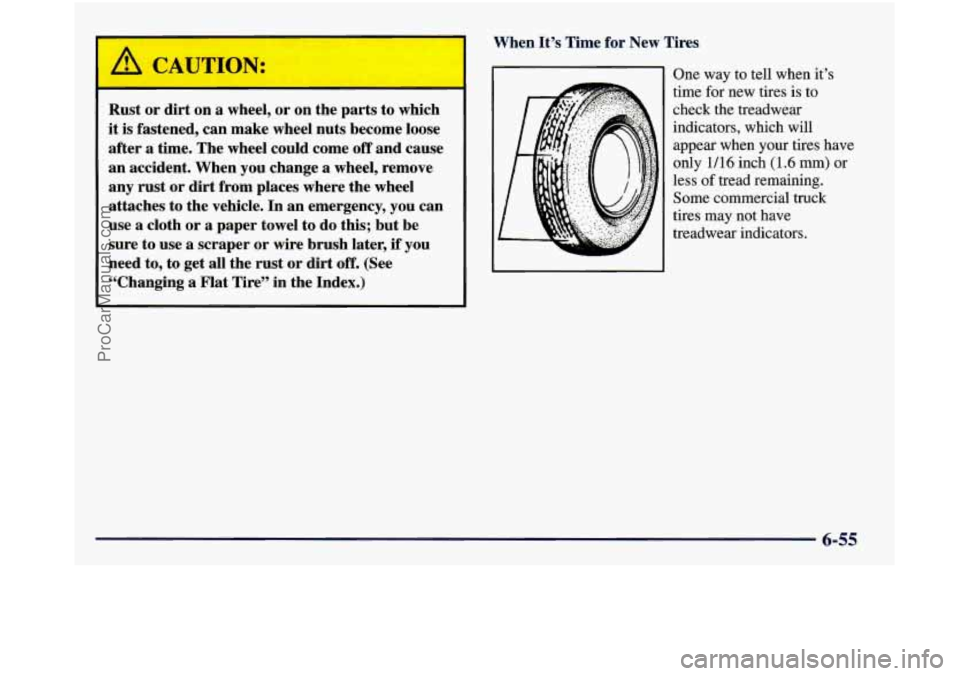
A CAUTION:
Rust or dirt on a wheel, or on the parts to which
it is fastened, can make wheel nuts become loose
after a time. The wheel could come
off and cause
an accident. When you change
a wheel, remove
any rust
or dirt from places where the wheel
attaches to the vehicle. In an emergency, you can
use a cloth or a paper towel to do this; but be
sure to use a scraper or
wire brush later, if you
need to, to get all the rust
or dirt off. (See
“Changing
a Flat Tire” in the Index.)
1 When It’s Time for New Tires
One way to tell when it’s
time for new tires is to
check the treadwear
indicators, which will
appear when your tires have
only
1/16 inch (1.6 mm) or
less of tread remaining.
Some commercial truck
tires may not have
treadwear indicators.
6-55
ProCarManuals.com
Page 346 of 452
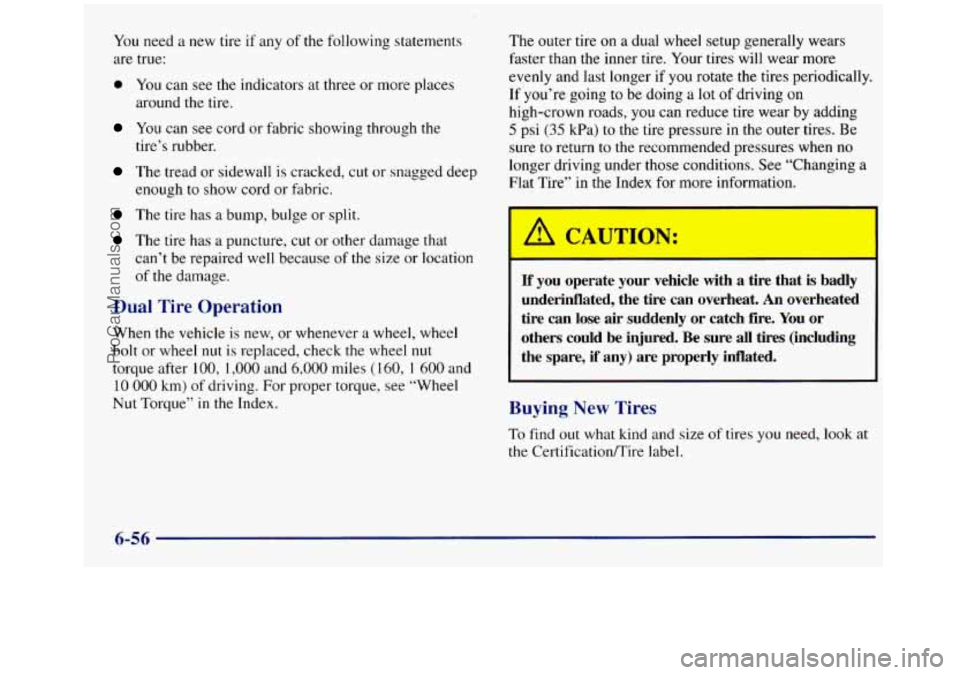
You need a new tire if any of the following statements
are true:
0 You can see the indicators at three or more places
around the tire.
You can see cord or fabric showing through the
tire’s rubber.
The tread or sidewall is cracked, cut or snagged deep
enough to show cord or fabric.
The tire has a bump, bulge or split.
The tire has a puncture, cut or other damage that
can’t be repaired well because of the size or location
of the damage.
Dual Tire Operation
When the vehicle is new, or whenever a wheel, wheel
bolt or wheel
nut is replaced, check the wheel nut
torque after 100, 1,000 and 6’000 miles (160, 1 600 and
10 000 km) of driving. For proper torque, see “Wheel
Nut Torque”
in the Index. The outer
tire
on a dual wheel setup generally wears
Faster than the inner tire. Your tires will wear more
evenly and last longer if
you rotate the tires periodically.
If you’re going to be doing a lot
of driving on
high-crown roads,
you can reduce tire wear by adding
5 psi (35 kPa) to the tire pressure in the outer tires. Be
sure to return to the recommended pressures when
no
longer driving under those conditions. See “Changing a
Flat Tire’’ in the Index for more information.
If you operate your vehicle with a tire that is badly
underinflated, the tire can overheat. An overheated
tire can lose air suddenly or catch fire.
You or
others could be injured. Be sure all tires (including
the spare,
if any) are properly inflated.
Buying New Tires
To find out what kind and size of tires you need, look at
the CertificatiodTire label.
6-56
ProCarManuals.com
Page 348 of 452
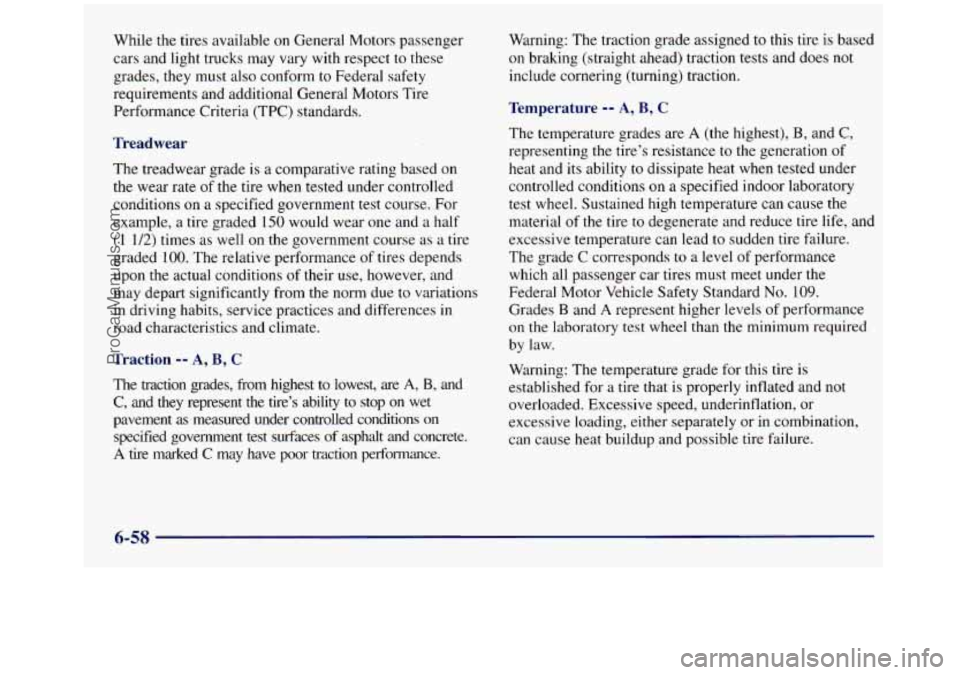
While the tires available on General Motors passenger
cars and light trucks may vary with respect to these
grades, they must also conform to Federal safety
requirements and additional General Motors Tire
Performance Criteria (TPC) standards.
Treadwear
The treadwear grade is a comparative rating based on
the wear rate of the tire when tested under controlled
conditions on a specified government test course. For
example, a tire graded 150 would wear one and a half
(1 1/2) times as well on the government course as a tire
graded
100. The relative performance of tires depends
upon the actual conditions of their use, however, and
may depart significantly from the norm due to variations
in driving habits, service practices and differences in
road characteristics and climate.
Traction -- A, B, C
The traction grades, from highest to lowest, are A, B, and
C, and they represent the tire’s ability to stop
on wet
pavement
as measured under controlled conditions on
specified government test surfaces of asphalt and concrete.
A tire marked C may have poor traction performance. Warning:
The traction grade assigned to this tire is based
on braking (straight ahead) traction tests and does not
include cornering (turning) traction.
Temperature -- A, B, C
The temperature grades are A (the highest), B, and C,
representing the tire’s resistance to the generation of
heat and its ability
to dissipate heat when tested under
controlled conditions
on a specified indoor laboratory
test wheel. Sustained high temperature can cause the
material of
the tire to degenerate and reduce tire life, and
excessive temperature can lead to sudden tire failure.
The grade
C corresponds to a level of performance
which
all passenger car tires must meet under the
Federal Motor Vehicle Safety Standard
No. 109.
Grades B and A represent higher levels of performance
on the laboratory test wheel than the minimum required
by law.
Warning: The temperature grade for this tire is
established for a tire that is properly inflated and
not
overloaded. Excessive speed, underinflation, or
excessive loading, either separately or in combination,
can cause heat buildup and possible tire failure.
6-58
ProCarManuals.com
Page 350 of 452
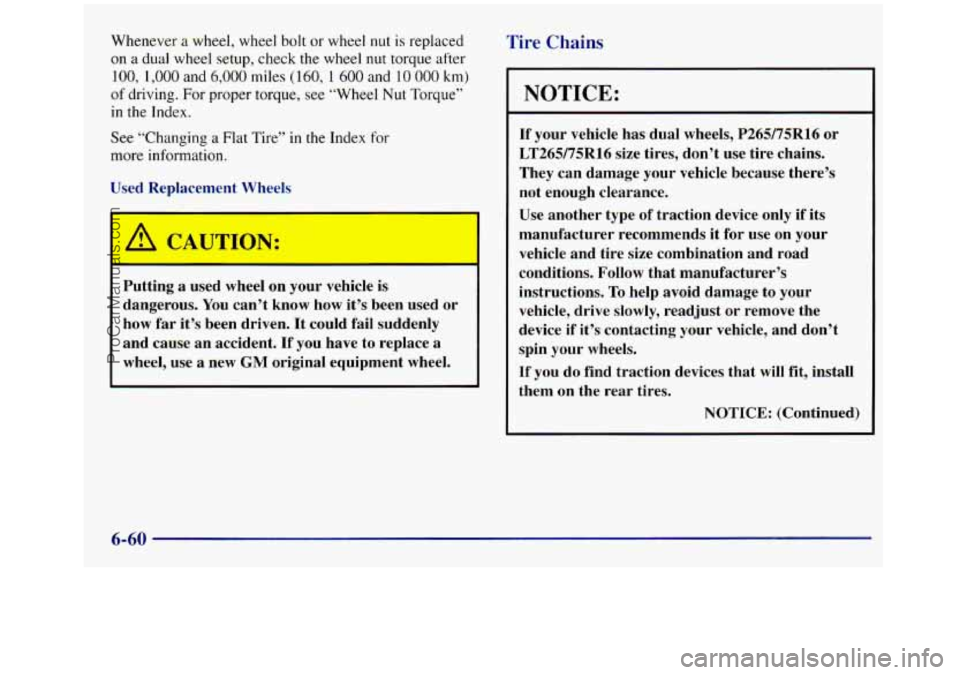
Whenever a wheel, wheel bolt or wheel nut is replaced
on
a dual wheel setup, check the wheel nut torque after
100, 1,000 and 6,000 miles ( 160, 1 600 and 10 000 km)
of driving. For proper torque, see “Wheel Nut Torque’’
in the Index.
See “Changing
a Flat Tire” in the Index for
more information.
Used Replacement Wheels
/!1 CAUTION:
Putting a used wheel on your vehicle is
dangerous.
You can’t know how it’s been used or
how
far it’s been driven. It could fail suddenly
and cause an accident. If
you have to replace a
wheel, use a new GM original equipment wheel.
Tire Chains
NOTICE:
If your vehicle has dual wheels, P265/75R16 or
LT265/75R16 size tires, don’t use tire chains.
They can damage your vehicle because there’s
not enough clearance.
Use another type of traction device only
if its
manufacturer recommends it for
use on your
vehicle and tire size combination and road
conditions.
Follow that manufacturer’s
instructions. To help avoid damage to your
vehicle, drive slowly, readjust or remove the
device
if it’s contacting your vehicle, and don’t
spin your wheels.
If you do find traction devices that will fit, install
them on the rear tires.
NOTICE: (Continued)
6-60
ProCarManuals.com
Page 372 of 452
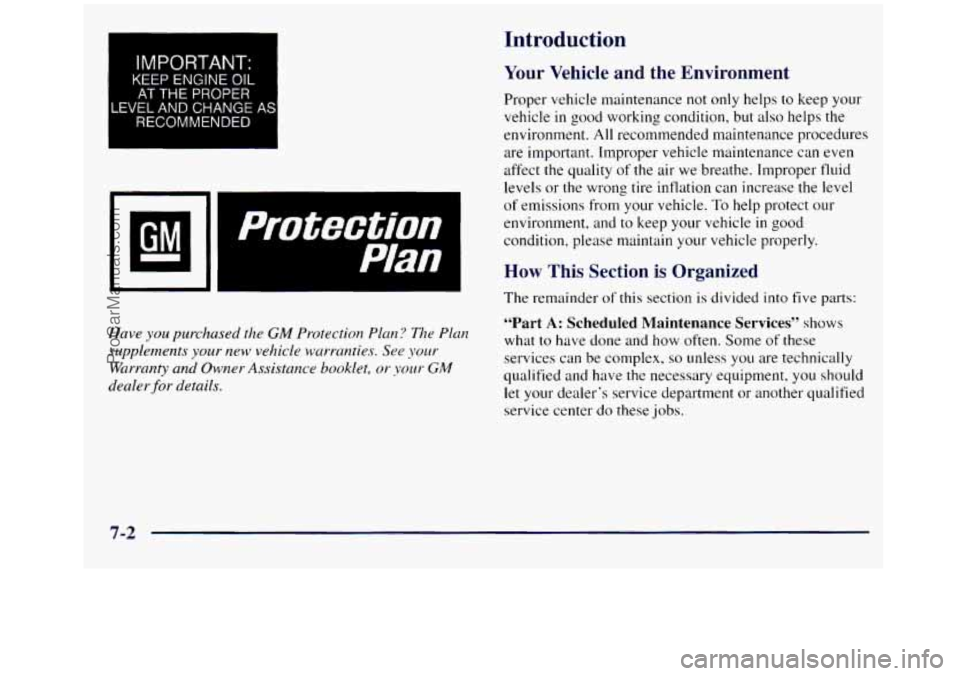
LE
IMPORTANT-
KEEP ENGINE OIL
AT THE PROPER
,VEL AND CHANGE
RECOMMENDED
AS
Have you purchased the GM Protection Pl~rn? The Plan
supplements your new vehicle M:u-ranties. See your
Warranty and Owner Assistance booklet,
or your GM
dealer-for details.
Introduction
Your Vehicle and the Environment
Proper vehicle maintenance not only helps to keep your
vehicle in good working condition, but also helps the
environment.
All recommended maintenance procedures
are important. Improper vehicle maintenance can even affect the quality
of the air we breathe. Improper fluid
levels or the wrong tire inflation can increase the level
of emissions from your vehicle.
To help protect our
environment, and to keep your vehicle
in good
condition, please maintain your vehicle properly.
How This Section is Organized
The remainder of this section is divided into five parts:
“Part A: Scheduled Maintenance Services” shows
what to have done and how often. Some
of these
services can be complex,
so unless YOLI are technically
qualified and have the necessary equipment, you should
let
your dealer‘s service department or another qualified
service center do these
jobs.
7-2
ProCarManuals.com